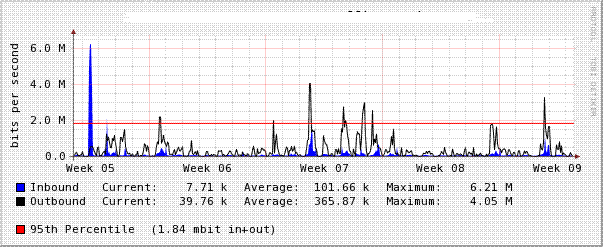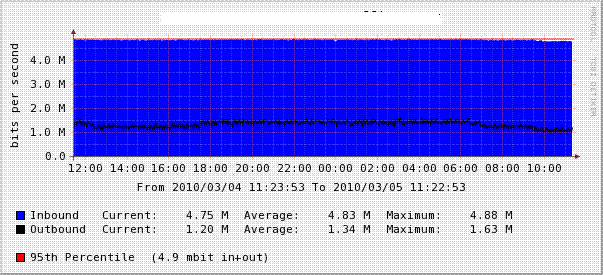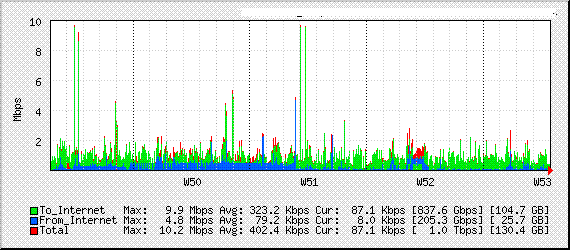
Colocation Bandwidth
By Erik Rodriguez
Tags: Types of Colocation Bandwidth, 95th Percentile, Bandwidth Billing, Cross-connect, ,rate-limited bandwidth, Burstable, 100 Mbps Commit
This article provides information on the different types of bandwidth options for data center colocation. Several different types of billing options are discussed and examples are provided. If you are looking for colocation information other than bandwidth, see colocation facilities.
Bandwidth in Colocation Space
Colocation providers usually have many different types of customers. Some require more rackspace and less bandwidth, others require the opposite. The options can vary depending on the provider or data center, and some will only offer 1 or 2 different options. Depending on the situation, one option may be a better fit than the others. Listed below are the most common bandwidth options for colocation:
- 95th percentile
- Rate-limited connection
- Total transfer
- Cross-connection to a provider
95th Percentile
95th percentile is generally the most common. Using this method there is no limit on how fast data will transfer. Technically the limitation is the speed of the port provided. Meaning, if customers are provided 95th percentile on a 100 Mb port, the theoretical maximum would be 100Mbps. 95th percentile is calculated by taking samples of the data transfer over a period of time (usually samples every 5 minutes over the entire month) and dropping the top 5 percent of traffic. To make a long story short, this allows for .bursting. with paying a higher fee. Basically this means that 36 hours worth of the highest bandwidth will NOT be used in calculating the bandwidth bill. The following is a sample cost for 95th percentile:
A $40/Mbps commitment with $60 per additional Mbps.
The following example shows bandwidth utilization of a port and its 95th percentile:

As you can see, there are several spikes of traffic well over the 1.84 Mbps that was calculated as the 95th percentile. The table below outlines the pro's and con's of using 95th percentile bandwidth:
| PRO |
CON |
| Access to higher amount of bandwidth |
Variable billing |
Ability to transfer large amount of data
for small amounts of time |
Rate-limited
Rate-limited connections are fairly easy to understand. A port is provided with a maximum rate established by the provider. The rate cannot exceed its pre-defined threshold. For example, a customer may purchase a colocation package with 1Mbps of bandwidth. This means traffic cannot transfer any faster than 1Mbps. That speed is defined by the provider and programmed into their equipment. Some allow for bursting, but that is not nearly as robust as the bursting with 95th percentile. Usually, this means something like .1Mbps burstable to 2Mbps.. This temporarily (usually 5 minutes maximum) allows for a burst up to 2Mbps. The table below shows the total amount of data per GB (gigabyte) that could be transferred during the entire month using a rate-limited billing plan. Note that network traffic would need to sustain the maximum rate-limit around the clock for 30 days to transfer the following totals:
| Rate |
Total Tranfer (in Gigabytes) |
| 1Mbps |
320GB |
| 2Mbps |
640GB |
| 3Mbps |
960GB |
| 4Mbps |
1280GB |
| 5Mbps |
1600GB |
| 6Mbps |
1920GB |
| 7Mbps |
2240GB |
| 8Mbps |
2560GB |
| 9Mbps |
2380GB |
| 10Mbps |
3200GB |
The following example shows bandwidth utilization of a port rate-limited to 5 Mbps:

As you can see, traffic never went above the 5 Mbps threshold. The table below outlines the pro's and con's of using rate-limited bandwidth:
| PRO |
CON |
| Fixed billing |
Difficult to transfer large amounts of data |
|
Usually more expensive than 95th per Mbps |
Total Transfer
Total Transfer is the best of both worlds. Like 95th percentile, the maximum transfer speed is determined by the port. The total amount (usually per GB) is predefined. This type of billing is usually fixed. However, some providers will charge a fee for the amount of GB over the predefined standard. Others will simply shut down the port once the threshold is reached. Although, the amount of transfer included with these packages is usually very generous. This is usually anywhere from 750GB-2500GB per month. Note that is in Gigabytes. Total transfer billing is popular among dedicated servers, but some colo providers offer it as well.
The following example shows bandwidth utilization for a server with total transfer:

As you can see, traffic was only limited to the port speed of the server, in this case 10 Mbps. The sum of bandwidth transferred is shown in the bottom right of the graph. The table below outlines the pro's and con's of using total transfer bandwidth:
| PRO |
CON |
| Access to high amount of bandwidth |
Difficult to transfer large amounts of data |
Ability to transfer large amount of data
for small amounts of time |
| Amount of total transfer is usually very generous |
Cross-Connecting
Cross-connecting to a provider is usually only done by large colocation customers. For many reasons, larger customers may require a direct connection with a specific bandwidth provider. These reasons could include being part of an MPLS network, customer-base primarily residing on a specific network, personal preference of the organization, or pricing from specific bandwidth provider. A quick example would be a customer with 4 cabinets who averages around 150 Mbps sustained bandwidth utilization also has other locations with the same 4 cabinet setup. They may prefer to use a provider like Level 3 Communications as they have a presence in nearly every data center. Generally speaking, communication between all other sites will be better if the data never has to leave the Level 3 network.
In such case, the colocation provider would charge the customer a "cross connect fee." This is a fee associated with directly connecting the 4 cabinets to the Level 3 network. Once connected, the customer would then pay Level 3 directly for any bandwidth used, typically via 95th percentile.
Conclusion
Remember, depending on the situation, one of these methods may be a better fit than another. Every provider should or be able to show a graph like the ones above per customer request. When purchasing bandwidth per Mbps, the rate should decrease as the number of Mbps increases. Here is some sample pricing for 95th percentile and rate-limited bandwidth:
Rate Limited:
1-5 Mbps = $70 (I.E. - Choose 4 Mbps, total cost per month would be $320)
6-10 Mbps = $60 (I.E. - Choose 10 Mbps, total cost per month would be $600)
11-20 Mbps = $50 (I.E. - Choose 20 Mbps, total cost per month would be $1000)
Notice the price changes, by going with the third set of prices (using 20 Mbps) , the cost savings is $400.
95th Percentile:
5 Mbps commit = $250 with $70 per Mbps overages
100 Mbps commit = $1500 with $40 per Mbps overages
Notice with 95th as the commit increases, the rate descreases as well.
|
|
|
